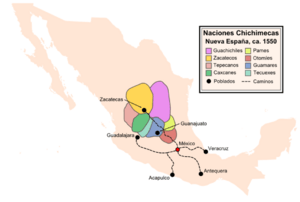Chichimeca facts for kids
The Chichimeca were groups of people who lived in Mexico a long time ago. They were mostly nomadic, meaning they moved from place to place. These groups lived in what is now the Bajío region of Mexico.
The Nahua people of Mexico first used the name "Chichimeca." It was a general term for these nomadic groups. The word had a meaning similar to "barbarian," which the Romans used for other groups. The Spanish Empire later adopted this name.
For the Spanish, the Chichimeca were seen as wild people. They lived by hunting and did not have permanent homes. They wore very little clothing. The Chichimeca bravely fought against outsiders entering their land. This land was important because it had silver mines that the Spanish wanted. The Chichimeca were also known for practicing sacrifices. They were feared for their skill and toughness in war.
The arrival of the Spanish caused a big drop in the number of Chichimeca people. Many groups disappeared over time. Today, only a few thousand people are still called Chichimecs. These are the Chichimeca Jonaz, who live in the state of Guanajuato.
What Does "Chichimeca" Mean?
The name Chīchīmēcah comes from the Nahuatl language. It means "inhabitants of Chichiman." Chichiman means "area of milk."
Some people thought the name was linked to the Nahuatl word chichi, meaning "dog." However, the way the words are pronounced is different. The vowels in Chīchīmēcah are long, which changes the meaning.
How Did They Live?
In the late 1500s, a Spanish writer named Gonzalo de las Casas wrote about the Chichimeca. He had lived near Durango and fought in wars against them. He described groups like the Pame, Guachichile, Guamari, and Zacateco. These groups lived in an area the Spanish called "La Gran Chichimeca."
Las Casas wrote that the Chichimeca only wore clothing to cover their groins. They painted their bodies. Their food came from hunting animals, roots, and berries. He also wrote that Chichimeca women would keep traveling on the same day after giving birth. This was to show how tough they were.
The Spanish also noted that the Chichimeca did not worship idols. This was different from many other native groups in the area.
Wars with the Spanish
The Chichimeca fought many battles against the Spanish. They would raid Spanish settlements and ambush important trade routes. They also looted goods. The Chichimeca War lasted for a long time, from 1550 to 1590.
At first, the Spanish tried to defeat the Chichimeca groups with harsh warfare. But they found it very difficult to win. The Chichimeca's small, quick attacks were very effective.
To end the war, the Spanish decided to try a different approach. They started a program called "Purchase for Peace." They gave the Chichimeca food, tools, and animals. They also gave them land. Spanish people were sent to teach the Chichimeca how to farm. The Spanish also tried to convert them to Catholicism.
Within about 100 years, the Spanish and Chichimeca began to mix. They started to live together and share cultures.
See also
 In Spanish: Chichimeca para niños
In Spanish: Chichimeca para niños


